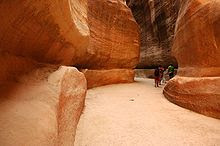'Passage-way Leading to Petra'
"The Treasury"
Clay water pipes that were used in Petra
system over 3000 years ago.
system over 3000 years ago.
Petra, is a Greek word that literally means rock. In this instance, or this context, it is a historical city located within the nation of Jordan that is famous for its rock cut architecture (shown in top image above) as well as its water conduit systems. Petra is the most famous and stunning site in all of the country, and is located south of Amman , Jordan
It’s been described as “a rose-red city half as old as time” as well as “one of the most precious cultural properties of man's cultural heritage”. Petra
The site remained unknown to most the entire Western world until 1812, when it was re-discovered by a Swiss explorer named Johann Ludwig Burckhardt; temples, tombs, monasteries and other buildings are all carved from the rosy colored sandstone cliffs. It is believed that construction began as early as 1200 BC by the Nabataeans, an industrious Arab people who settled in southern Jordan
In fact, Excavations have shown that it was the ability of the Nabataeans to control the water supply that led to the rise of the desert city in the first place, creating an artificial oasis of a sort. According to archeological evidence, flash floods were not frequent but when they did occur the Nabataeans controlled those floods by the use of dams, cisterns and water conduits. These innovations stored water for prolonged periods of drought, and enabled the city to prosper by making this asset available to the public.
According to Arab ancient writings, Petra
It is possible to reach the ancient city of Petra
Around the time of Jesus Christ Petra flourished most; during that time period it was the most sensible route for traveling through the mountains; so traders bringing back silk from China in route to Europe often traveled this route. During that era, the people of Petra
Unfortunately for the city of Petra Petra
Sources …
http://en.wikipedia.org/wiki/Petra http://www.soothbrush.com/petra-jordan-pictures/ http://www.atlastours.net/jordan/petra.html



No comments:
Post a Comment